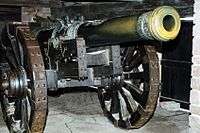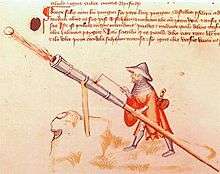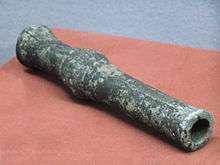Hand cannon
| Part of a series on |
| Cannon |
|---|
 |
| History |
| Operation |
| By country |
| By type |

A hand cannon or gonne (also spelled handgonne to distinguish the device from modern handguns) (Chinese: 手銃; Arabic: مدفع; Russian: пищаль) is one of the early forms of firearm. It is possibly the oldest type of small arms, as well as the simplest type of early firearm, as most examples require direct manual external ignition through a touch hole without any form of firing mechanism. It may also be considered a forerunner of the handgun.[1] The hand cannon was widely used in East Asia and later throughout Europe until at least the 1520s, when it was supplanted by matchlock firearms. The oldest surviving hand cannon is the Heilongjiang hand cannon, which was manufactured no later than 1288.[2]
In modern usage, the term hand cannon may also be used colloquially to refer to a pistol or revolver chambered for a powerful cartridge, such as the .454 Casull or .500 S&W Magnum. This term is also sometimes used to refer to a novelty toy gun known as "pocket artillery", a small cannon firing steel balls by means of a smokeless powder or a firecracker.
Origins

The general consensus is that hand cannons originated in China and were spread from there to the rest of the world.[3] The earliest surviving firearm is the Heilongjiang hand cannon, which was manufactured no later than 1288.[3] The Heilongjiang hand cannon weighs 7.8 pounds,[3] and could be carried by a soldier.[4] The earliest artistic depiction of a hand cannon is a firearm-wielding figure that was found in twelfth-century Sichuan.[3] The earliest reliable evidence of hand cannons in Europe comes from the 14th century,[1][3] during which time both Europeans and Arabs appear to have begun using them.[3] In East Asia, the Koreans acquired knowledge of the hand cannon from China in the 14th century.[3] Japan was already aware of gunpowder warfare but did not mass-produce firearms until 1543, when the Portuguese introduced matchlocks known as tanegashima.[5]
Design and features

The hand cannon was a simple weapon, effectively consisting of a barrel with some sort of handle, though it came in many different shapes and sizes. Although surviving examples are all completely constructed of metal, evidence suggests that many were attached to some kind of stock, usually wooden. Other examples show a simple metal extension from the barrel acting as the handle. In fact, not all hand cannons used metal at all in their construction, as some Chinese illustrations demonstrate bamboo tubes being used instead.
For firing, the hand cannon could be held in two hands, while a helper applied the means of ignition. These could range from smoldering wood or coal, red-hot iron rods, to slow-burning matches. Alternatively, the hand cannon could be placed on a rest and held by one hand, while the gunner applied the means of ignition himself. Projectiles used in these weapons were varied, with many utilizing a variety of different ammunition. Rocks or pebbles found on the ground could be fired from hand cannon, while more sophisticated ammunition such as iron or stone in the shape of balls and arrows could also be used.
Later hand cannons were made with a flash pan attached to the barrel and a touch hole drilled through the side wall of the gun instead of the top of the barrel. The flash pan had a leather cover and, later on, a hinged metal lid, fitted to keep the priming powder dry until the moment of firing and to prevent premature firing. These features were carried on over to subsequent firearms.
Due to the poor quality of powder that was often used in these weapons and their crude construction, they were not effective missile weapons, as early examples often lacked sufficient power to punch through light armour. All were inaccurate, due to the awkward handling as well as the aforementioned poor quality of the weapons. While the noise and flash may have had some psychological effect on the enemy, many early hand cannons were utilized in a minor capacity and so lacked battlefield presence.
The invention of corned powder, the slow match, and the serpentine in mid-15th century Europe led to much more effective firearms and eventually to increased adoption. It also prompted the development of the first matchlock firearms, which could be more effectively aimed and fired than hand cannon. Gradually, the hand cannon became obsolete, although it found use in some locales up until the 20th century.
Impact
Firearms, of which the hand cannon was an early example, gradually came to dominate European warfare. The hand cannon was inexpensive and easy to mass-produce. The hand cannon could act as a terror weapon to troops and horses that had never seen the weapon before. Much like the crossbow, the weapon could be effectively used by new recruits.
.jpg)
While the hand cannon could not match the accuracy nor speed of fire of the longbow, gunners did not require the special training and continuous practice from childhood required of an expert bowman. Yew, the primary stave-making material for the European longbow, became scarcer as the medieval period progressed. Firearms only supplanted longbows in England after almost all European yew supplies had been exhausted.
The development of the hand gun did not directly lead to the decline and eventual disappearance of bow and arrows. They co-existed for several generations, each using different tactics. Bows could take advantage of their superior range while hand cannons could be used in a similar manner to how combat shotguns would be used today. Improvements in hand cannons – better gunpowder, shot ammunition, and development of the flash pan – led to 16th century arquebusiers, deployed on the flank of pike block in tercio formation.
See also
References
- 1 2 Ancient Discoveries, Episode 12: Machines of the East, History Channel, 2007 (Part 4 and Part 5)
- ↑ Chase, Kenneth Warren (2003). Firearms: A Global History to 1700. Cambridge University Press. p. 32. ISBN 978-0-521-82274-9.
- 1 2 3 4 5 6 7 Chase, Kenneth Warren (2003). Firearms: a global history to 1700. Cambridge University Press. ISBN 978-0-521-82274-9. Retrieved 11 June 2011.
- ↑ Needham, Joseph (1987). Science and Civilisation in China: Military technology: The Gunpowder Epic, Volume 5, Part 7. Cambridge University Press. p. 304. ISBN 978-0-521-30358-3.
- ↑ Tanegashima: the arrival of Europe in Japan, Olof G. Lidin, Nordic Institute of Asian Studies, NIAS Press, 2002 P.1-14
External links
| Wikimedia Commons has media related to Hand cannon (handgonne). |
- Handgonnes and Matchlocks
- Ulrich Bretschler's Blackpowder Page
- Maitre Jehan de Montsiler - the first recorded hand gunner